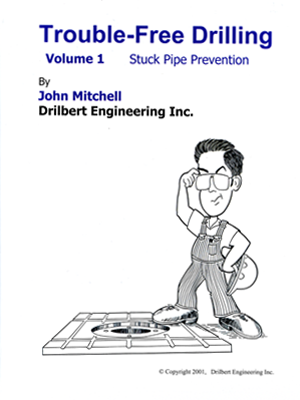Trouble-Free Drilling

TROUBLE-FREE DRILLING
PREFACE
This book is intended to help drilling personnel improve their understanding of the down hole mechanics of drilling. The focus of this book is the physics of stuck pipe.The mechanics of what causes stuck pipe is explained in great detail.Warning signs, preventive measures, and various freeing procedures are also discussed.Some of this material is based on personal observations and experiments and has never been presented before.Most of the information, however, is based on the hundreds of technical papers I researched while writing this book.
The drilling industry has devoted a lot of effort to the problem of stuck pipe in research facilities around the world.The first technical paper on this subject was written in 1937; today, the topic of stuck pipe appears in more than 8,000 technical papers and books.Unfortunately, most of the men and women working on rigs are not even aware that this research exists.This information is of no use if it does not reach the people in the field.The primary goal of this book is to get this information to rig-based engineers and supervisors in an easy-to-understand format.
The people on the rig drill the well.They are the ones who need to understand stuck pipe prevention.In particular, drillers and drilling supervisors must have this understanding.A thorough understanding is not easy to obtain.Most technical papers focus on a very narrow portion of the whole picture, and are written in a manner that is difficult even for an engineer to comprehend.
I have attempted to capture the information that is most useful to the driller and present it clearly and simply, with strong visual support from pictures and graphs.Unfortunately, non-technical people may still find some of this material to be difficult to comprehend, especially the material on hole cleaning and well bore instability.Drilling is an engineering subject.It simply cannot be fully understood without the language of physics and math.I have tried to keep the physics and math as simple as possible, but the more educated the reader is, the easier this book will be to comprehend.
Education is a tool to help us interpret our experiences.Experience and education work together; one is worthless without the other.The more education we get up front, the better we can interpret our experiences.However, we will not benefit from our experiences if we do not carefully observe and analyze them.We must study the cause and effect relationship of everything we see and do.If we analyze our experiences, we will learn from them.Experience is thus an education, and education is part of our experience.
An education in engineering gives an individual a huge advantage toward interpreting and understanding his experiences on the rig.It is crucial to pass this understanding along to other rig hands.The people on the rig drill the well.They are the ones who must understand the science and art of drilling if we are to perform well.
Unfortunately, there are those who believe the men who work on rigs are not capable of understanding the material presented in this book.I strongly disagree with this sentiment.Seventeen years at the rotary table taught me that the men I rubbed elbows with are every bit as intelligent as the engineers in the office.This book will be challenging for most rig-based personnel.It is, however, a challenge they are up to.Like me, they will probably need to read it many times.Not everyone will fully understand every concept presented¾but every reader will increase their understanding of downhole mechanics.A fundamental responsibility of any engineer or scientist is to build a bridge for those who follow behind.That is exactly what this book is intended to be¾a bridge to help others obtain the deeper understanding of drilling problems that I have devoted most of my career pursuing.


